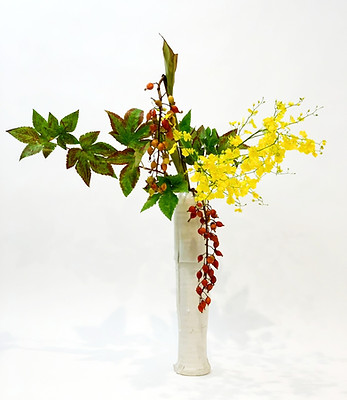梶井宮御流のスタイル
当流では江戸期以来の継承されているスタイルを古典花、明治時代以降から継承されているスタイルを現代花と位置づけております。
さらに古典花は古典花(生花)と先代二十世が新たに創案した現代に対応する近代生花の二つ、現代花は自由花に代表される投入花と盛花の二つを指導しております。
古典花(生花)

江戸期より継承される生花スタイルのいけばなは、江戸の町衆の気風が生み育てたものと言えます。
たくさんの役枝で構成する立華が公武の広い床を飾ったのに対し、生花は一間ないし半間の町衆の床を飾るにふさわしく、三本の役枝(真・行・留 :当流では三行体と呼んでおります)を基本にあくまでもシンプルに構成し、軽快さを尊びつつ格調を持たせたものです。「いき」という町衆が好んだ美意識を表わすものと言えるでしょう。
このため当流では型はもとより、器の水際からの立ち上がりを大切にします。水際は細くすっきりと一本にまとめ、斜めに立ち上げた役枝を広げて型に整え、緊張感のある豊かな空間を生み出します。これは花材の特性を知り、その生彩をとらえる心があってはじめて花型も生き、格調のある作品になるでしょう。
投入

投入花の歴史は古く、「いけばな」の成立(室町時代)以前から行われてきた挿花(そうか)という自然的行為に見ることができます。美しい花を手折って器に入れ、生活空間を飾るという行為は日本に限らず、世界の様々な民族がやってきたことです。
しかしこれが「いけばな」という美的表現、独特な文化にまで高めたのは我が国だけでした。四季の変化に恵まれ、湿潤な気候が多様な植物を豊かに生育させるという環境、さらに『万葉集』や『古今集』にみられるように、人と自然は一体のものとする自然観と美意識がこれを育んだといえます。
当流の源 三千院は創建以来、院内の居住空間に挿花が常にありました。挿花は時代の好みを反映し、やがて「抛入花」(投入花)としてのスタイルをととのえて今日へと継承してきたものです。
投入花は主として瓶や壺など、あまり口の広くない器を用い、この器の口から上の花材の展開と、器がもつフォルムとの一体感が大切なポイントになります。数多くいけることでこのバランス感覚は養われ、瑞々しく美しい一瓶が表わせるようになるでしょう。
盛花

文明開化といわれた明治時代、一気に流入した西欧の文化は、わが国のそれまでの生活を一変させるものでした。こうした状況のなかで新たに生みだされたいけばなが「盛花」でした。
盛花は、口の広い水盤などの器に、”盛る”ようにいけます。このためにテーブル花のように正面性をもたない四方見の花にすることもでき、多彩な展開が可能です。
現代花としての投入花と盛花は、それぞれのスタイルとそのバリエーションで今日のあらゆる空間に対応することができるベーシックなものと言えましょう。





